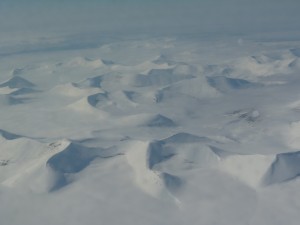Climate change and the Arctic Treeline
A report released by Cambridge University suggests that the treeline in the Arctic is not moving northwards as fast as earlier studies have predicted. The report, published by Gareth Rees from the University’s Scott Polar Research Institute says the relationship between climate change and trees is more complex than previously thought.
Rees says the treeline is clearly moving north on average, but that he has not found evidence confirming other estimates that the treeline is moving north at as much as two kilometres a year. He says 100 metres per year is more realistic.
The study involves researchers in northern Europe, Canada, Alaska and Scandinavia.
More in Environmental Research Letters or in a summary on the Alaska Dispatch
Of birds and bears in a changing Arctic climate
Living conditions have changed considerably over the last few decades for sea birds who live or breed in the Arctic region.
Ornithologist George Divoky has found that his monitoring of black guillemots on the Arctic Cooper Island off the coast of Barrow, Alaska over the last four decades has turned into observation of the rapidly changing climate in the high north.
![]() read more
read more
Oil from the Arctic: Is it time for an Arctic Treaty?
Given the increased interest in drilling for oil and gas in the Arctic as the area becomes more accessible in a changing climate, concern is also growing about the dangers an accident could pose to the fragile environment of the “high North”. An editorial in the publication NATURE argues that we need a binding agreement like the Antarctic Treaty to protect the Arctic from pollution.
![]() read more
read more
Climate change in pictures while you wait…

Alaska and south America are the regions where the glaciers are currently melting fastest, according to a report released in Cancun. I experienced that first-hand in Alaska in 2008, when I started the ice blog.

This is one of the pictures taken from the Begich Boggs glacier visitors centre. There’s a visiting centre purpose built to see the Portage glacier – but where the glacier has retreated so far it’s no longer visible from this point at all.In 2008, we were told it had receded more than 2 miles in 70 years.
On the last official day of Cancun, the wrangling is still going on – same procedure as every year? A freelance colleague dropped in just now . “There doesn’t seem to be anything happening in Cancun”.. he said. Yeah, that seems to be the feeling. My colleague Nathan Witkop from the Living Planet programme is there. You might like to read
his latest summary while you’re waiting.
I’ve also been keeping an eye on the Global Ideas blog You might enjoy a look at that.
And if you are interested in watching some more pictures and video and reading/hearing from some researchers in the field, have a look at these pictures from Lars Hansen who took some great shots at the Zackenberg Monitoring Station in Greenland.
That will all help pass the time waiting for the Cancun closer…
Arctic Chukchi Sea – to drill or not to drill?

I’ll never forget the beauty, the silence and the wonder of stepping out on the frozen Arctic waters of the Chukchi Sea in Barrow, Alaska.

Ice Blog Archive Alaska 2008
Nor will I forget the tales of the Inupiat people of the changes to the ice and the consequences for wildlife, like polar bears and whales.
On the same trip, I visited Prince William Sound. That site of great natural beauty was also the location of the Exxon Valdez disaster, just over 20 years ago. At first sight, you don’t notice that, but underneath some of the rocks you find traces of oil, which takes a long, long time to break down in the cold Arctic waters.
So it’s with some concern that I follow the controversy over plans by Royal Dutch Shell to drill for billions of barrels of oil in the Chukchi Sea this year. The sea lies between Alaska and Siberia and is thought to hold large quantities of oil and gas.
The US authorities conditionally approved the plans to drill three exploratory wells in December 2009. The decision was delayed on the grounds that the area is a prime habitat for polar bears, now recognized by US law as a threatened species.
Now indigenous and conservationist groups are suing to stop the project.
Concern from the Northern Alaska Environmental Centre
The oil industry has a strong position in Alaska. It provides around 40% of the state’s tax revenue and provides a lot of funding for the University of Alaska. Shell says it is working to improve its environmental impact. But the environment lobby is not happy that enough is known about the potential impacts of further drilling and the changes being brought by climate change. With the race to get at the Arctic’s natural resources speeding up as the region warms – more than twice as fast as the rest of the planet – the risk of development without adequate research on environmental impacts seems to me to be increasing all the time.
“Shell comes under attack in Alaska” – in THE GUARDIAN























Feedback